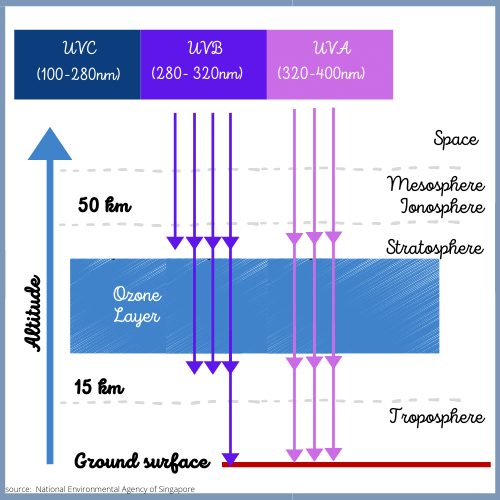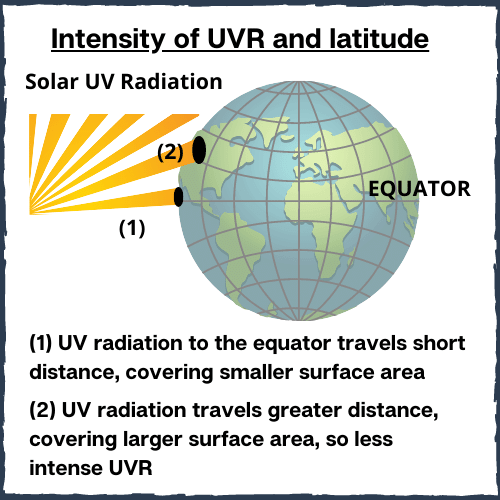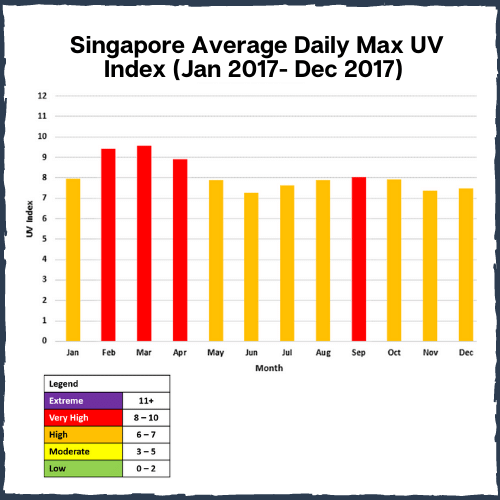Just to remind you, UV radiation is made of shorter wavelength UVB and longer wavelength UVA rays.

Approximately 5% of UV radiation reaching the ground’s surface is UVB radiation and the remainder is UVA radiation. Specifically, most of UVA radiation is UVA 1 radiation. This is absolutely critical to me when I assess sunscreens. At the front of my mind is this constant question: does the sunscreen contain UV filters that scatter, absorb or otherwise reduce the impact of UVA 1 radiation.
Other factors determine the intensity of UV radiation that reaches the surface (and therefore our skin). In today’s blog, we will be looking at these factors.
Factor 1: Latitude of location
Solar UV radiation is strongest at the equator, as the solar radiation is directly overhead and has less distance to travel. Also, the UV radiation is covering a smaller surface area than compared to cities away from the equator.

Cities that are close to the equator are Bogota, Nairobi, Kuala Lumpur and Singapore.
Factor 2: Time of the day
UV radiation is most intense between 10am and 3pm because the UV radiation takes the most direct path to the earth’s surface and therefore is more intense. During the early morning and late afternoon, the sun’s radiation passes at greater angle through the atmosphere and more of it is absorbed into the atmosphere.
This shows the change in UV Index levels for Singapore (see blog below on Solar UV Index explanation). But briefly, as the SNEA write, “the UVI is an international standard index that describes the level of solar UV radiation on the earth’s surface. The index ranges from 0 to 11+ and the values are grouped into various exposure categories. A higher index value indicates a greater potential for harmful effects to the skin and eyes.”

Factor 3: Altitude
Per the WHO, with every 1,000m increase in altitude UV intensity increase by 10%. At higher altitudes, the atmosphere is thinner and less radiation is absorbed.
Importantly, this holds for UVA radiance. Blumthaler et al have observed that, ” under cleary sky conditions, the observed increases in UV irradiance is affected by altitude (altitude effect). UVA irradiance increases by 9%±2% per 1000 m, which is consistent with the WHO guidelines.
Factor 4: time of the year
During the summer, the sun is closer to the earth and has less distance to travel and is therefore more intense. Also, the rate of UV absorber molecules in the Troposphere (lowest level of the atmosphere) are at a minimum during the summer, when the sun radiates vertically. During the spring, the ozone layer thickens a bit and their is less transmission of UV radiation.

Factor 5: cloud cover
I read a really technical (and hideously) boring journal article on cloud cover and its relation with UV radiation, so that you don’t have to. I also feel as if I should be awarded a medal of some description for this endeavour.
Anywho, the short story is this:
- For any given Solar Zenith Angle, the cloud cover plays the most significant contribution (vs. other factors) to the amount of solar UV exposure on the earth’s surface.
- Cloud cover does affect UVB radiation. Very thick and dense cloud cover will help absorb and scatter UV radiation, making the UV radiation less intense. Light or thin cloud cover has minimal impact on UV radiation intensity and may in fact help scatter UV radiation.
- With respect to UVA radiation, I was able to figure out from this paper, that at a given Solar Zenith Angle, the UVA radiation passing through cloud cover (and therefore) reaching the earth’s surface does depend on cloud cover intensity. This is the baby interpretation of the paper’s main finding

Factor 6: reflective surfaces
Surfaces and how they reflect UV radiation will add to overall UV radiation intensity.

How about glass?
Even if UVB radiation is absorbed by glass, its unlikely that longer wavelength and deeper penetrating UVA radiation is. I like to compare glass to my dermis. I know UVA radiation is penetrating my skin to reach my dermis and collagen. Will glass really offer a hurdle? Secondly, if you are driving to work in the summer/winter or like me, working right next to a window, you should slap on some sunscreen.
Remember, when in doubt, the answer is always apply sunscreen.
Sources and uses
M. Blumthaler, W. Ambach, R. Ellinger, Increase in solar UV radiation with altitude, Journal of Photochemistry and Photobiology B: Biology, Volume 39, Issue 2, 1997, Pages 130-134,
A.V. Parisi, N. Downs, J. Turner, Evaluation of the cloudy sky solar UVA radiation exposures, Journal of Photochemistry and Photobiology B: Biology, Volume 138, 2014, Pages 141-145
Jezdimir Knezevic. Impact of High-Altitude Ultraviolet Radiation on Functionability of Flight Crews. Arch Biomed Eng & Biotechnol. 2(2): 2019. ABEB.MS.ID.000533.
Yolanda Sola, Jerónimo Lorente, Contribution of UVA irradiance to the erythema and photoaging effects in solar and sunbed exposures, Journal of Photochemistry and Photobiology B: Biology, Volume 143, 2015, Pages 5-11.
WHO, US EPA, Singapore Environmental Agency
